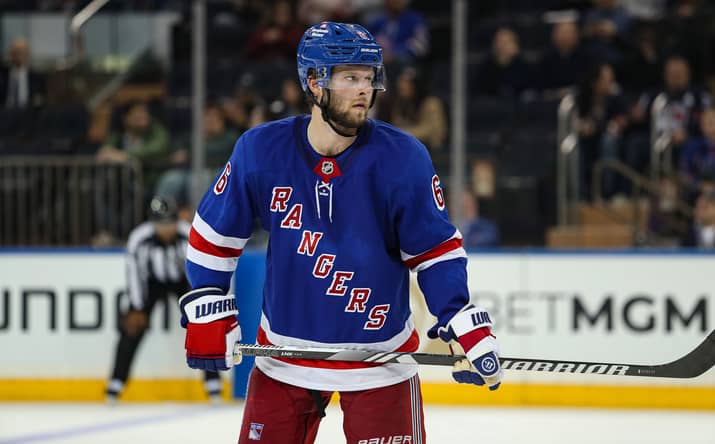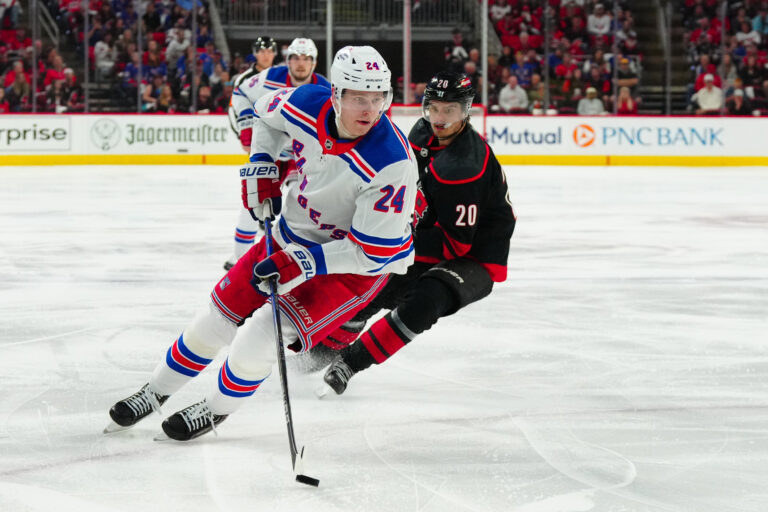Zac Jones is playing with the kind of confidence he’ll need to take advantage of his chance to grab a full-time role on the New York Rangers blue line. Coach Peter Laviolette is among those who’ve noticed.

“I think he’s played good minutes for us,” Laviolette said Friday. “He had a big night the other night (Tuesday), and I thought last night (Thursday) he was solid. I think when a player gets in there and they start to get confidence with how they’re moving the puck, how they’re defending, if they’re generating offense, I think that can add confidence and build you.”
Jones scored twice, had an assist and played 24:57 on Tuesday, when the Rangers used a six-goal third period to overcome the New York Islanders 6-4. He didn’t hit the score sheet on Thursday in New York’s 5-2 win against the Boston Bruins at Madison Square Garden, but he did block two shots and was plus-1 while playing 19:43.
After spending all of last season with the Rangers but playing in just 31 games, Jones was regarded as having the inside track on a third-pair role after Erik Gustafsson left as a free agent this summer. But Laviolette feels the 23-year-old’s game still has more room to grow.
“I think so,” he said. “There’s probably steps to go. He’s pretty valuable as he sits already for our team and what he does and the way he plays the game and the way he skates, the minutes he takes down, who he plays against. But the impact on the penalty kill, the impact on the power play, to be able to go out there and find those minutes. I think that helps build confidence, when you’re feeling the puck and you’re on the power play and you’re doing good things as positive results.
“Those are good things; you can build on that. So, yes, I think there’s room.”
Rangers still waiting for Kappo Kakko to grow into an impact player
Laviolette took some responsibility on breakup day last June for not getting more out of Kaapo Kakko after the second player chosen in the 2019 NHL Draft had a disappointing season that included being a healthy scratch during the Stanley Cup Playoffs. He’s eager to see Kakko expand his role this season.
“Nothing has changed in regard to that,” he said of the end-of-season conversation with Kakko. “The conversation is from last year. I think that the player is always looking for an opportunity to expand his role, to have an impact on the team.
“I had mentioned that you try to target some players to try to elevate their game. He was one of them, and it probably didn’t hit the way he wanted or the way I wanted or we wanted. Those conversations were just to reset and come back into camp in great shape, which he did, and find more of an impact inside the game.”

Kakko hasn’t had a point in the two preseason games he’s played, but Laviolette was pleased with his play in New York’s win against Boston on Thursday, when the 23-year-old forward led the Rangers with seven shots on goal.
“I thought his line last night was really good,” the coach said of the trio of Kakko, Filip Chytil and Will Cuylle. “I thought the puck was on his stick quite a bit. To be able to have that balance and that kind of depth in your top nine, wherever it pans out, can make you a really dangerous hockey team. Nothing has really changed from that with regard to going into this season. I’m sure (he’d) like to be a part of the power-play units. I’m sure (he’d) like to have more minutes, more impact. I’d like to facilitate that if I can. It’s got to be warranted as well, but it’s been a good start for him.”
Sam Carrick makes positive impression in Rangers debut
Sam Carrick sat and watched the Rangers first two preseason games before getting into the lineup on Thursday. He didn’t have a point but finished plus-1 in 15:21 of ice time.
It was Laviolette’s first look at the 32-year-old in game action, and he liked what he saw.
“Last night was his first game, so I haven’t worked with him in regards to games a lot like maybe some of the other players,” he said.
Carrick, a free agent who signed a three-year, $3 million contract with the Rangers on July 1, is “a guy we’re going to count on for face-offs, penalty kill, some physicality, a little bit of edge to his game. That line, going out there with a 4-2 lead, defensive-zone starts, I thought they did a pretty good job.”
Carrick is a career bottom-six forward, a center who plays with grit, can kill penalties and chip in a bit offensively.
“There’s definitely a need and a role for that on our team – guys who can go out there and play with an edge when the game’s on the line,” Laviolette said. “Those are the opportunities we put him in last night, and I thought he did a good job.”
Training camp can be balancing act in building penalty kill
Camp is a time for young players and newcomers to show what they can do, sometimes in roles they don’t normally find themselves in — such as penalty-killing. Part of a coach’s task in the preseason is to learn about the new guys while also getting his regular power-play units and penalty-killers ready for the new season.
“Our penalty kill was pretty successful last year (the Rangers were third-best in the NHL at 84.5 percent) and pieces are in place,” Laviolette said when asked about this season’s PK units. “Sometimes in training camp there’s players in and out of the lineup. If Mika (Zibanejad) and (Chris Kreider) aren’t in, that’s two players out, so it’s an opportunity to look at two different players.
“It’s a balance too, because you can’t just say, ‘Let’s try all of those new guys.’ The guys who do do it on a regular basis need to find their timing inside a training camp. They need to find their reads, they need to get comfortable with what they’re doing. We’ve got a new guy, Reilly Smith, who’s killed (penalties) in the past and has done a good job with it. He’s trying to find some continuity with the system and the person he might kill with.”



